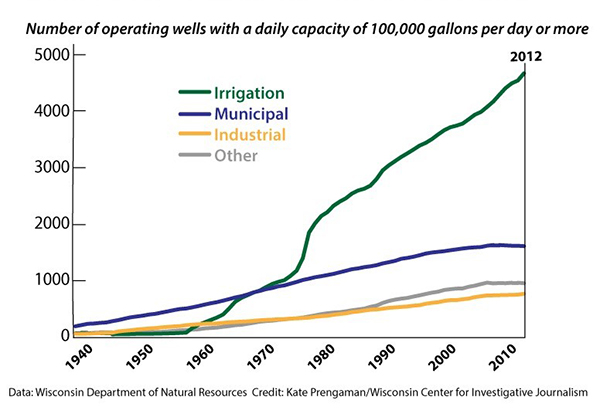Welcome to DU!
The truly grassroots left-of-center political community where regular people, not algorithms, drive the discussions and set the standards.
Join the community:
Create a free account
Support DU (and get rid of ads!):
Become a Star Member
Latest Breaking News
General Discussion
The DU Lounge
All Forums
Issue Forums
Culture Forums
Alliance Forums
Region Forums
Support Forums
Help & Search
General Discussion
Related: Editorials & Other Articles, Issue Forums, Alliance Forums, Region ForumsGroundwater: Diminishing Resource, Increasing Conflict
Scott Walker's DNR limits its own power to regulate high-capacity wells.
http://www.wisbar.org/NewsPublications/WisconsinLawyer/Pages/Article.aspx?Volume=88&Issue=7&ArticleID=24218
Wisconsin’s waters have been protected since before it was a state. The concept of the public trust doctrine, or the state holding navigable waters in trust so they remain forever free and open to the public, was passed down from the Northwest Ordinance to the Wisconsin Constitution, article IX, section 1.1 State statutes have since been crafted to protect Wisconsin’s groundwater and surface water and to give the Wisconsin Department of Natural Resources (DNR) primary responsibility for overseeing this resource.
But Wisconsin’s waters are facing a threat: they are being dried from the bottom up. As high-capacity wells proliferate in Wisconsin, water in groundwater-fed streams and lakes is being diverted to these wells beneath the surface, reducing surface water levels and stream flows. At the same time, the DNR has been working to implement Lake Beulah Management District v. DNR, the 2011 Wisconsin Supreme Court decision that held the DNR “has the authority and a general duty to consider whether a proposed high capacity well may harm waters of the state.”2
...

Both the number of well applications and the amount of water pumped have increased over time. In 2013, total withdrawals for irrigation statewide were 101 billion gallons; in 2012, which saw a summer drought, withdrawals reached 135 billion gallons.11 Research has connected these withdrawals to flow reductions and drying of streams and lakes in the Central Sands, beyond effects attributable to climate or natural fluctuations. For example, Long Lake in Plainfield, which previously had a maximum depth of approximately 10 feet, dried completely in 2006. The Little Plover River, a high-quality trout stream, was near dry in 2003 and has dried annually in stretches since 2005.12
...
Yet the DNR contended that it lacked authority to consider cumulative impacts in individual permit decisions. The agency’s chief argument cited the “modified reasonable use doctrine” in State v. Michaels Pipeline, a public-nuisance case filed on behalf of homeowners who experienced property damage and dried wells as a result of dewatering for a sewer pipe installation project.19 The decision rejected the prior rule of nonliability for virtually any use of groundwater, instead holding that withdrawals may trigger liability if they cause unreasonable harm by lowering the water table or reducing artesian pressure. Because the case discussed and recognized liability in terms of substantial harm caused by an individual water user, the DNR argued it could not deny a permit based on harm caused by multiple other water users.
But Wisconsin’s waters are facing a threat: they are being dried from the bottom up. As high-capacity wells proliferate in Wisconsin, water in groundwater-fed streams and lakes is being diverted to these wells beneath the surface, reducing surface water levels and stream flows. At the same time, the DNR has been working to implement Lake Beulah Management District v. DNR, the 2011 Wisconsin Supreme Court decision that held the DNR “has the authority and a general duty to consider whether a proposed high capacity well may harm waters of the state.”2
...

Both the number of well applications and the amount of water pumped have increased over time. In 2013, total withdrawals for irrigation statewide were 101 billion gallons; in 2012, which saw a summer drought, withdrawals reached 135 billion gallons.11 Research has connected these withdrawals to flow reductions and drying of streams and lakes in the Central Sands, beyond effects attributable to climate or natural fluctuations. For example, Long Lake in Plainfield, which previously had a maximum depth of approximately 10 feet, dried completely in 2006. The Little Plover River, a high-quality trout stream, was near dry in 2003 and has dried annually in stretches since 2005.12
...
Yet the DNR contended that it lacked authority to consider cumulative impacts in individual permit decisions. The agency’s chief argument cited the “modified reasonable use doctrine” in State v. Michaels Pipeline, a public-nuisance case filed on behalf of homeowners who experienced property damage and dried wells as a result of dewatering for a sewer pipe installation project.19 The decision rejected the prior rule of nonliability for virtually any use of groundwater, instead holding that withdrawals may trigger liability if they cause unreasonable harm by lowering the water table or reducing artesian pressure. Because the case discussed and recognized liability in terms of substantial harm caused by an individual water user, the DNR argued it could not deny a permit based on harm caused by multiple other water users.
InfoView thread info, including edit history
TrashPut this thread in your Trash Can (My DU » Trash Can)
BookmarkAdd this thread to your Bookmarks (My DU » Bookmarks)
1 replies, 1297 views
ShareGet links to this post and/or share on social media
AlertAlert this post for a rule violation
PowersThere are no powers you can use on this post
EditCannot edit other people's posts
ReplyReply to this post
EditCannot edit other people's posts
Rec (4)
ReplyReply to this post
1 replies
 = new reply since forum marked as read
Highlight:
NoneDon't highlight anything
5 newestHighlight 5 most recent replies
= new reply since forum marked as read
Highlight:
NoneDon't highlight anything
5 newestHighlight 5 most recent replies
Groundwater: Diminishing Resource, Increasing Conflict (Original Post)
Scuba
Jul 2015
OP
riversedge
(70,192 posts)1. You can be sure that the DNR had Walker's OK.